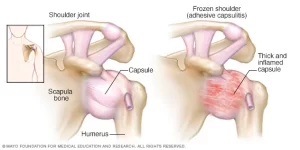
Shoulder pain and stiffness can be frustrating—especially when it limits your ability to work, exercise, or even sleep. At Livfit Physio Mornington, we help people every week with frozen shoulder treatment, guiding them through recovery with expert assessment, personalised exercises, and hands-on care. Here’s what you need to know.

What is Frozen Shoulder?
Frozen shoulder, also called adhesive capsulitis, happens when the flexible capsule surrounding your shoulder joint becomes inflamed, thickened, and tight. This leads to pain and a gradual loss of movement.
Frozen shoulder usually develops slowly and passes through three stages:
- Freezing stage – Pain builds gradually, and stiffness increases.
- Frozen stage – Pain may ease, but stiffness is at its worst.
- Thawing stage – Movement gradually returns.
Frozen Shoulder Symptoms
If you’re experiencing any of these symptoms, it’s worth seeing a physio for frozen shoulder as early as possible:
- Dull, deep pain in the shoulder
- Marked stiffness—especially reaching overhead or behind your back
- Difficulty sleeping on the affected side
- Gradual worsening over weeks to months
Common Causes of Frozen Shoulder
You’re more likely to develop frozen shoulder if you’ve had:
- A shoulder injury or surgery (especially if your arm was immobilised)
- Prolonged time in a sling after a fracture
- Medical conditions like diabetes or thyroid problems
- Sometimes, no clear cause—it can appear “out of the blue”
Stage 1: Freezing Stage – Pain Management is Key
In the early stage, the goal is to reduce pain while keeping the joint moving within safe limits.
Do this:
- Keep moving your shoulder in gentle, pain-free ranges several times a day
- Use heat before exercises to relax muscles
- Sleep with a pillow under the arm for support
- Take pain relief (as recommended by your GP) so you can stay active
Avoid this:
- Forcing your arm through painful movements
- Completely resting the shoulder—stiffness will worsen
- Heavy lifting or overhead tasks
Stage 2: Frozen Stage – Regain Movement
At this stage, pain may settle, but stiffness is at its peak. Physiotherapy for frozen shoulder is most effective here to gently stretch and mobilise the joint capsule.
Focus on:
- Gentle stretching exercises like pendulum swings and assisted arm lifts
- Behind-the-back towel stretches
- Hands-on joint mobilisation with your physio to improve flexibility
Avoid:
- Aggressive stretching that causes sharp pain—it can make inflammation worse
- Skipping exercises—daily mobility work is essential
Stage 3: Thawing Stage – Build Strength & Function
Once movement starts to return, it’s time to strengthen the shoulder so you can get back to full function.
Do this:
- Progressive strengthening for the rotator cuff and shoulder blade muscles
- Functional exercises that match your work, sport, or hobbies
- Continue mobility work until pain-free
What NOT to Do with Frozen Shoulder
- Don’t wait and hope it resolves—without treatment, frozen shoulder can last years
- Don’t stop exercises as soon as pain settles—strengthening prevents future issues
- Don’t compare your progress to others—recovery speed varies greatly
Frozen Shoulder Treatment at Livfit Physio Mornington
At Livfit Physio, we aim to get you moving as soon as possible. Your treatment may include:
- Hands-on mobilisation to loosen the joint capsule
- A personalised exercise program for each stage of recovery
- Education on activity pacing and preventing recurrence
- Guidance for safe return to work, sport, and daily activities
Frozen shoulder can be frustrating, but with the right approach, most people regain full movement and function. We’ll help you get there—step by step.
📞 Call Livfit Physio Mornington today on 5976 8447 or book in online to book your frozen shoulder assessment and start your recovery.